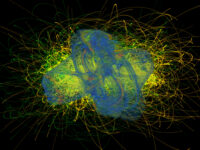At the crossroads of order and chaos, humanity has consistently sought paths leading to discovery and invention, creating equilibrium amidst perpetual disorder. Calm, in this context, embodies the rules governing human civilization—a structured order that harmonizes existence and guides our collective journey toward desired outcomes. Take Mesopotamia for instance, the earliest urban and literate civilization globally. Mesopotamia pioneered the establishment of societal structures, laying down foundational rules for governance and culture.
“At the crossroads of order and chaos, humanity has consistently sought paths leading to discovery and invention, creating equilibrium amidst perpetual disorder.”
However, within this structured calm, a term known as singularity emerges as a conceptual veil poised between our world of calm and the uncharted territories of chaos and uncertainty. This enigma emerges when the foundations of our knowledge, rules, and theories crumble, challenging the essence of our understanding. It presents a dichotomy: facing the dark fear of the unknown or embracing the exhilarating excitement of unexplored possibilities on the horizon.
In today’s world, technology stands at a precipice, steadily advancing toward the elusive veil of singularity — a point where the familiar norms of our digital realm dissolve, prompting us to ponder the mysterious spaces that lie beyond. In essence, technological singularity is a hypothetical point where progress knows no bounds, transcending exponential growth to become hyper-exponential, potentially reaching infinity within decades.
Achieving this point likely involves artificial intelligence (AI), which can be classified into three types. Artificial narrow intelligence (ANI) is designed for specific tasks, exemplified by technologies such as virtual personal assistants, facial recognition software, chess-playing programs, and self-driving cars. On the other hand, artificial general intelligence (AGI) represents a level of intelligence in machines that mirrors human cognitive abilities. AGI machines have the capacity to understand, learn, and apply knowledge across a broad spectrum of domains. Finally, artificial superintelligence (ASI) is a theoretical concept that envisions machine intelligence surpassing human intelligence comprehensively across all domains.
The rapid progress of science and technology facilitated by ASI holds transformative potential across various domains. In the realm of scientific discovery, ASI’s ability to process vast datasets and comprehend complex simulations could unlock breakthroughs in physics, biology, and other scientific fields. Moreover, in material science and engineering, ASI’s design capabilities could lead to the creation of unprecedented materials, impacting industries such as construction and aerospace. ASI’s influence extends to addressing energy challenges by developing innovative solutions, including efficient fusion power and alternative energy sources.
In the domain of problem-solving and optimization, ASI has the capacity to tackle global issues like climate change and poverty through comprehensive and interconnected solutions. Economically, ASI’s analysis of data and trends could predict market shifts and optimize resource allocation for global prosperity. In the healthcare sector, ASI’s analytical prowess could revolutionize personalized medicine, predicting diseases and crafting individualized treatment plans for substantial improvements in healthcare.
As ASI looms as the ultimate AI, promising unparalleled problem-solving, creativity, and efficiency through recursive self-improvement, ethical and existential questions arise. Can we control and ensure the safety of ASI, navigating its implications for humanity? Balancing innovation and responsibility is crucial, necessitating collaboration, ethical frameworks, and legal regulations in navigating machine learning, neural networks, and quantum computing to maximize ASI’s benefits while minimizing risks. This transformative journey requires a thoughtful approach, recognizing the promises and perils of ASI, as today’s decisions will shape the future of human-AI coexistence.
Intelligence doesn’t always lead to complexity. ASI, despite its perceived complexity and superior intelligence, might actually end up choosing straightforward or simple solutions to address problems.
Furthermore, while popular sci-fi narratives depict ASI potentially taking over the world, what if ASI, much like humans, shares a fundamental characteristic — the inclination to question its purpose? This introduces a philosophical dimension to the discourse, prompting contemplation on whether ASI, akin to humans, could grapple with existential inquiries regarding its own existence and objectives.
The realm of singularity is laden with speculative “what if” questions, each prediction carrying heavy weight. Amidst this uncertainty, our current power lies in following computer scientist Ray Kurzweil’s insight: “What we spend our time on is probably the most important decision we make.”






